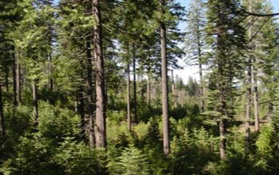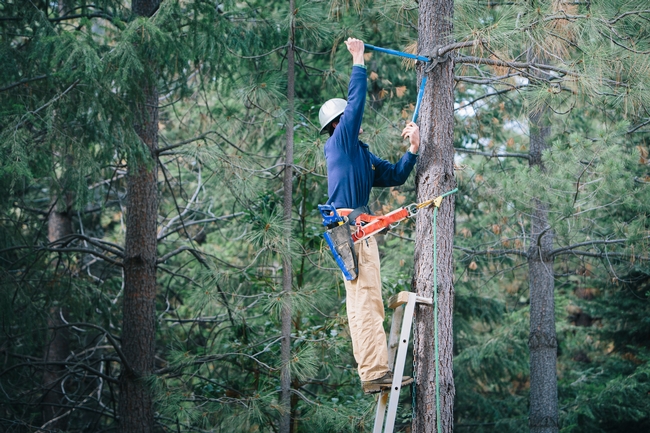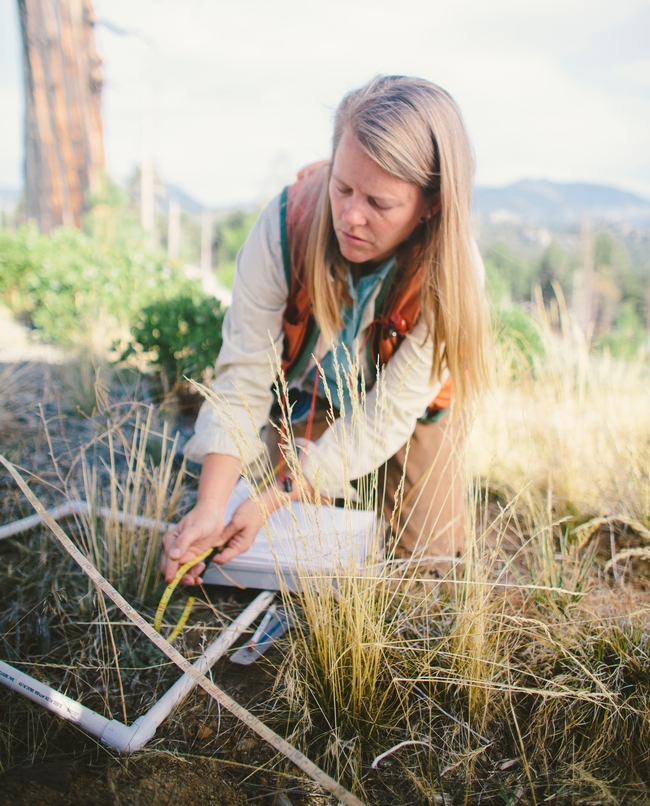- Author: Pamela Kan-Rice
Butte, Feather River, Lake Tahoe, Reedley and Shasta community colleges, Chico State, UC ANR and Sierra Business Council to train workers for urgently needed work
California's forested, rural communities are suffering from record-breaking wildfires that burned 2.5 million acres and destroyed multiple communities in 2021 alone. To create well-paying jobs and improve forest health and fire safety, the Sierra Nevada and Cascade regions have received $21.5 million for a project that will strengthen the infrastructure for workforce development and increase access to those jobs for local community members from all backgrounds.
The project, funded by the federal Good Jobs Challenge, is being rolled out by the Foundation for California Community Colleges, California State University Chico, University of California Agriculture and Natural Resources, and the Sierra Business Council.
“There is so much work to be done in California to increase the resilience of forests and communities to wildfires and climate change, and there are just not enough trained workers to do all this work,” said Susie Kocher, UC Cooperative Extension forestry and natural resources advisor for the Central Sierra. “A recent assessment estimated upcoming shortages of 6,000 fire managers, 4,000 conservation scientists and foresters, 7,000 loggers and 1,500 utility line clearance technicians. California desperately needs skilled workers to fill those jobs to protect and rebuild communities in rural parts of the state. And these are well-paying jobs with benefits.”
The four-year project will help train and place qualified workers into high-quality jobs in the forestry sector, responding to urgent needs to build economic and climate resilience in California's forested, rural communities. Five community colleges – Butte College, Feather River College, Lake Tahoe Community College, Reedley College and Shasta College – California State University Chico, University of California Agriculture and Natural Resources and the Sierra Business Council are partnering on the project. This group has proven experience delivering effective workforce-training programs in partnership with industry and communities.
The emerging forestry and fire-safety sector has the potential to grow into a $39 billion industry. By working to recruit, support and train local community members in partnership with Hispanic-serving institutions, Indigenous-led partners and other community-based organizations, the project will expand the industry's talent pool while diversifying the field.
The “California Resilient Careers in Forestry” project is being awarded one of 32 grants from the $500 million Good Jobs Challenge funded by President Biden's American Rescue Plan and administered by the Commerce Department's Economic Development Administration.
“We are honored to be selected as one of the Good Jobs Challenge award recipients alongside a talented group of partners serving rural communities, including several of our California community colleges,” said Keetha Mills, president of the Foundation for California Community Colleges. “This work is critical to help Californians access good jobs, especially as we help our state respond to the urgent needs of climate change and support economic growth in regions greatly impacted by the COVID-19 pandemic and natural disasters.”
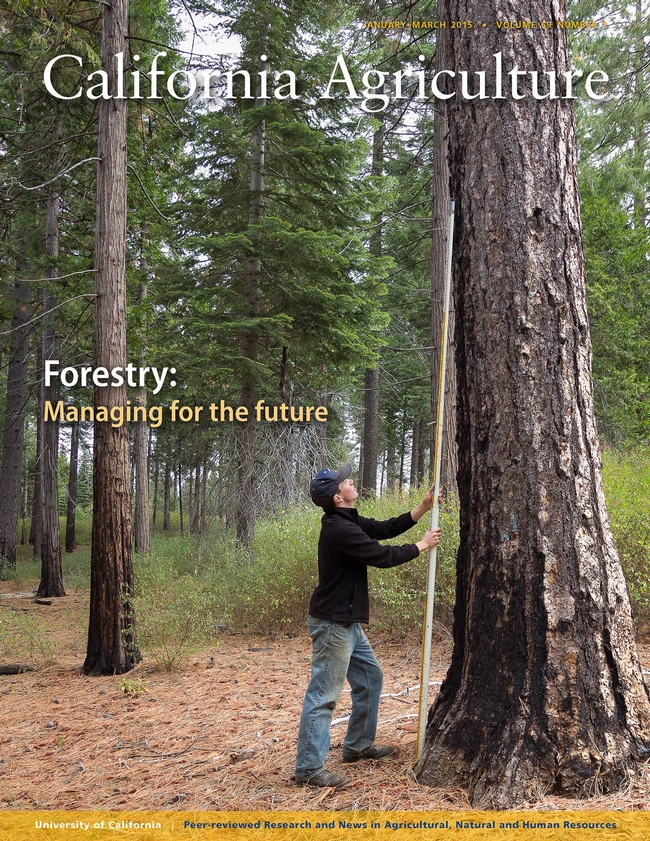
The latest issue of California Agriculture is devoted entirely to forestry, starting with the editorial on 100 years of forestry at UC Berkeley by College of Natural Resources Dean Keith Gilless. Other articles are listed below.
Research news:
Fewer trees, more water, safer forests: The Sierra Nevada Watershed Ecosystem Enhancement Project is investigating how tree thinning — which is needed urgently in much of the Sierra Nevada due to long-term fire suppression — may increase the water yield from forested watersheds by as much as 10 percent. Monetizing this increased water yield, as well as other benefits from healthier forest ecosystems, could help fund forest management.
Forest thinning may increase water yield from the Sierra Nevada
Protecting oak woodlands: On California's North Coast, grassy oak woodlands are being invaded by stands of Douglas fir at an alarming rate. A UC ANR–led research team is working to understand the reasons why and guide efforts to reverse the trend.
Conifer encroachment study will inform efforts to preserve and restore North Coast oak woodlands
Peer-reviewed Research
Remote sensing: The powerful mapping capabilities of Lidar soon may be widely available to California forest managers as costs fall and the technology improves.
Mapping forests with Lidar provides flexible, accurate data with many uses
Maggi Kelly and Stefania Di Tommaso
Forest carbon: Private forests that are harvested and regenerated yield approximately 30 percent more carbon sequestration benefits than if they are left to grow.
Carbon calculator tracks the climate benefits of managed private forests
William C. Stewart and Benktesh D. Sharma
Forest management: A long-term study in the Sierra Nevada confirms the negative consequences of preferentially removing large trees.
Large-tree removal in a mixed-conifer forest halves productivity and increases white fir
Robert A. York
Post-fire ecology: Nearly 30 years after a burn at two sites in northeastern California, sagebrush had recovered fully and invasive grasses had diminished.
Post-fire vegetation dynamics of a sagebrush steppe community change significantly over time
Sara K. Hanna and Kenneth O. Fulgham
Community engagement: All sides of the Sierra Nevada forest management debate have learned from SNAMP. Can stakeholders help ensure research results are part of future management?
UC plays a crucial facilitating role in the Sierra Nevada Adaptive Management Project
Adriana Sulak, Lynn Huntsinger and Susan D. Kocher
Ecosystem Restoration: A cooperative meadow restoration plan that successfully engaged a diverse group of stakeholders is a model for future projects.
Cooperative, cross-boundary management facilitates large-scale ecosystem restoration efforts
Erin Kelly and Jonathan Kusel
Community Fire Safety: The collaborative partnership has improved fire safety at the urban-wildland interface in fire-prone communities of Plumas, Butte and Yuba counties and stopped major wildfires.
UC Cooperative Extension works with fire safe councils to reduce wildfires
Glenn A. Nader and Michael De Lasaux
The entire California Agriculture issue can be downloaded at http://californiaagriculture.ucanr.edu.
California Agriculture is a peer-reviewed journal of research in agricultural, human and natural resources published by the University of California Division of Agriculture and Natural Resources. For a free subscription, visit http://californiaagriculture.ucanr.edu, or write to calag@ucanr.edu.
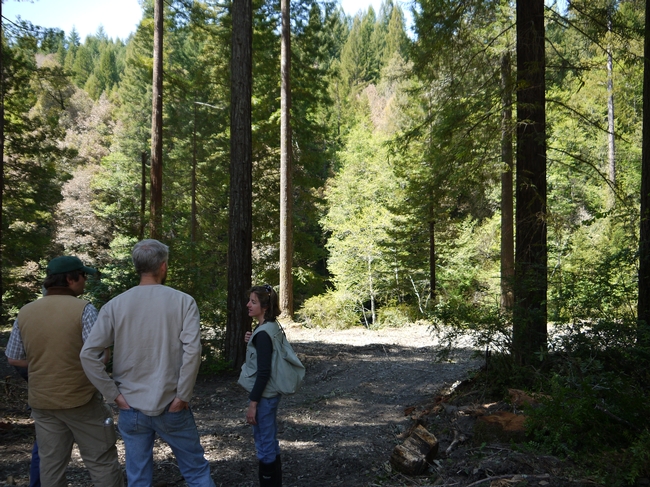
Federal and state agencies, including the USDA Forest Service, CAL FIRE and the Natural Resources Conservation Service, joined forces with UC Cooperative Extension and quickly mobilized resources to control the pathogen in Redwood Valley and halt its spread to neighboring forests. Local landowners have also played a key role.
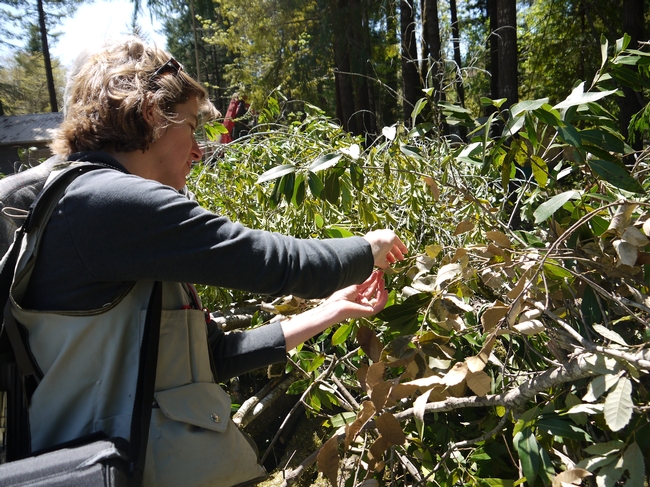
“We’ve been closely monitoring the disease for years and anticipating a scenario like Redwood Valley, so we were ready to take action and respond quickly,” Valachovic said.
The UCCE staff leads an extensive sudden oak death monitoring program on the North Coast, and one of their detection strategies involves "leaf-baiting" in streams. Using this technique, they “bait” Phytophthora ramorum, the non-native pathogen that causes sudden oak death, by placing susceptible leaves in strategic locations in North Coast streams. If the leaf baits become infected with SOD, the scientists know that the pathogen is present in the watershed without having to comb the landscape for symptoms.
After they detected the pathogen in Redwood Creek, UCCE acted quickly to pinpoint the source of the waterborne spores, scouring the watershed for the very inconspicuous symptoms of SOD with the help and permission of public and private landowners. By November 2010, the scientists had narrowed the location to Redwood Valley, where they found dead tanoaks and several other infected host plants.
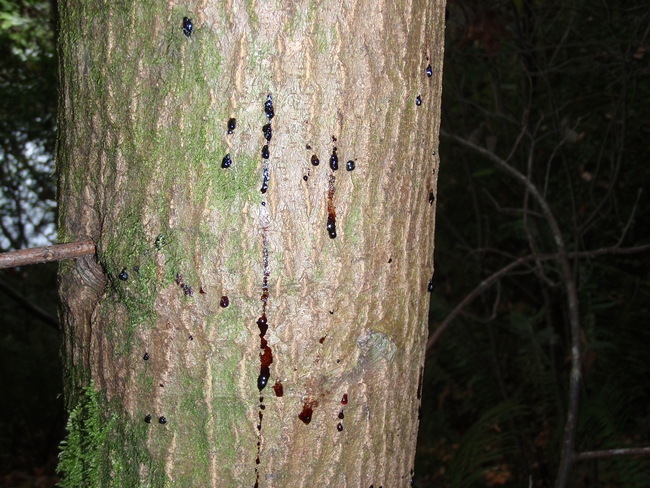
Much of the on-the-ground effort has been completed by contractors and CAL FIRE handcrews, who have created 100-meter buffers around infected trees by removing California bay laurel (pepperwood) and tanoak, the two hosts that most readily support P. ramorum spore production and spread. Infected plant material has been trucked offsite and donated to the nearby DG Fairhaven Power Company, piled and burned, or lopped and scattered onsite.
Funding from the American Recovery and Reinvestment Act, the USDA Forest Service and NRCS enabled the swift response in Redwood Valley. UCCE used ARRA funds, also known as federal stimulus funds, to hire four people to work on the project, lending stability to the effort.
Landowner support has been critical to the success of the project, according to Valachovic. More than 20 landowners in the valley have allowed monitoring and treatment activities on their properties, recognizing that their cooperation may keep the disease from spreading to other areas.
“We couldn’t just stand back and let the disease roll through the forests that we manage, and the landowners understood that,” said Dan Cohoon, who works for Eureka-based Able Forestry, which manages many of the private forestlands in the watershed.
Brandon LaPorte, manager of Cookson Ranch and one of the key landowner collaborators in Redwood Valley, has supported the project from the beginning. LaPorte explained, “We’ve learned a lot about the disease through this project, and we certainly don’t want it getting worse here on the ranch or spreading beyond the valley.”
The first phase of treatment is currently wrapping up, and UCCE is beginning to monitor project efficacy and watch for spread of the pathogen beyond project boundaries. The Yurok and Hoopa tribes will be paying close attention to this effort, as they are only a ridge away from the infestation.
Ron Reed, a Yurok tribal forester, commented, “Oaks are an important part of our culture and history, and we will do what we can to keep sudden oak death out of our forests.”
The Redwood Valley project highlights the value of stream monitoring as a detection tool for SOD, but it also demonstrates the ability of agencies and landowners to collaborate swiftly and effectively to protect the region’s forest resources. Maybe most important – regardless of the future course that sudden oak death takes in the North Coast – is what the project shows about the ability of proactive communities concerned about the health of their landscapes to come together, attract the support of state and national authorities, and work to make things better.
The community collaboration is being honored with the Two Chiefs’ Award. The award, which is given jointly by the NRCS and the Forest Service, highlights projects from across the country each year, recognizing exemplary partners who have worked collaboratively to support conservation and forest stewardship. Kathleen Merrigan, USDA deputy secretary, will present the award and Valachovic will accept the award on behalf of the federal, state, tribal and private partners involved the project at an event in Davis on Wednesday, May 16.
For more information about sudden oak death disease, visit the California Oak Mortality Task Force website at www.suddenoakdeath.org.
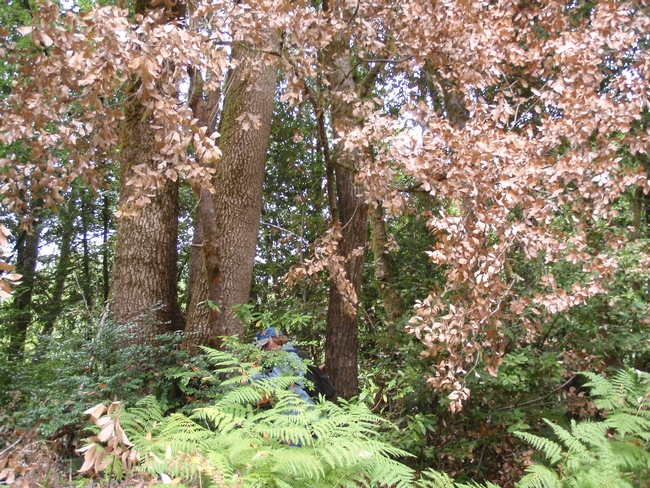
- Posted By: Brenda Dawson
- Written by: Pam Kan-Rice, (530) 754-3912, pskanrice@ucdavis.edu and Tong Wu, (510) 643-5429, Tongwu@berkeley.edu
October 4, 2011
The University of California is hosting a two-part workshop series, “Ties to the Land,” to help forest landowners pass their land and its legacy on to the next generation.
The first workshop is being offered at 11 locations throughout California. All workshops will be held from 6 p.m. to 8 p.m.
“Family forests create many benefits through their stewardship actions, but the legacy can fall prey to the confusing details of land titles, permits, and inheritance if families have not crafted a succession plan,” said Bill Stewart, UC Cooperative Extension forestry specialist and organizer of the series. “This is especially true for owners who do not live in the county where their forest is. Their heirs have probably spent little time on the land and the lack of shared goals can become a problem.”
During the first workshop, participants will learn the steps needed to plan for passing land along to their heirs. An important first step in this process is clarifying the current owners’ goals and values for their family forest or ranch. This allows landowners to start the discussion with heirs about their long-term vision for the property. Participants will also learn about the financial impacts of ownership transfers across generations.
This first round of identical workshops is being held before the holidays, to allow time for families to get together during the winter holidays and discuss their goals. Locations and dates for the first workshop are as follows:
- Nevada City, Tuesday, October 11
- Placerville, Monday, October 17
- Sonora, Wednesday, October 19
- Redding, Tuesday, October 25
- Yreka, Wednesday, October 26
- Quincy, Thursday, October 27
- Ukiah, Tuesday, November 8
- Garberville, Wednesday, November 9
- Eureka, Thursday, November 10
- Berkeley, Tuesday, November 15
- Rohnert Park, Wednesday, November 16
The second workshop will be held after the holidays and will cover the financial and legal approaches and tools such as trusts, limited liability companies, and easements used in succession planning as well as specific planning approaches used to manage land and resources. Dates and times of the second workshop will be announced later.
Registration for the workshop is $25 per family to cover costs of the family workbook and DVD. Multiple members of each family are encouraged to attend both workshops and can attend the workshop location nearest to them as the curriculum will be the same.
To register for the workshop or for more information on locations or the workshop series, please see the University of California Forest Research and Outreach website http://ucanr.org/tiestotheland.
